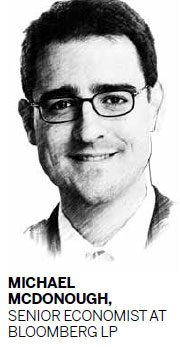Slowdown to continue


The Chinese government is signaling unprecedented tolerance for slower growth in the second half of 2013, as officials strive to swap fast, low-quality growth for more sustainable expansion, a senior economist has said.
An adjusted growth target of 7 percent may emerge in 2014, setting the country on a temporary turbulent journey toward a more-balanced economy, according to Michael McDonough, senior economist at Bloomberg LP.
But for the next six months, the government may still accelerate investment projects and cut interest rates, among other efforts to defend a 7.5 percent GDP growth target, he noted.
Since this year, China's macroeconomic data have consistently come in below analysts' forecasts, leading to a series of growth downgrades, he said. For instance, the government's 2013 GDP goal is 7.5 percent, well below January's consensus forecast of 8.1 percent.
On Monday, the National Bureau of Statistics said that GDP growth slowed to 7.5 percent in April to June, the ninth quarter in the past 10 that expansion has weakened.
It is interesting to note that historically, the government's target has acted more as a floor than a legitimate target. But this year that is very likely to change, McDonough said.
"They won't set next year's target below 7 percent, but I do think a general trend is going to be a continued slowdown. Slower growth will be a good thing, though it will inevitably cause some short-term pain. But in order to rebalance, you need to lessen the reliance on investment," he said.
The 4 trillion yuan ($651 billion) stimulus package enacted following the 2008 financial crisis, while bolstering growth, essentially led to a surge in credit expansion and generated extensive industrial overcapacity, which McDonough said was responsible for much of the current slowdown in China.
The overcapacity especially obvious in the manufacturing sector, where the Producer Price Index, a main gauge of inflation at the wholesale level, has dropped for 16 consecutive months, indicating tepid domestic demand.
Another case in point is the surging amount of social financing after the 2008 input, where an increasing portion of these loans, which targeted lower-valued projects, may struggle to stay afloat in an environment of slowing growth.
Annual new yuan loan-issuance between 2008 and 2012 was on average more than 140 percent above the 2007 level.
McDonough noticed a change in the response to the slowdown compared with five years ago.
"While the government still has room to increase investment in certain infrastructure projects that may boost urbanization, a goal the new leadership has highly valued, officials are showing a restrained response and instead, attempting to encourage more private-sector involvement," he noted.



















